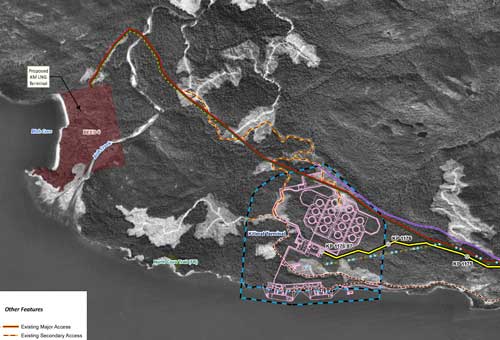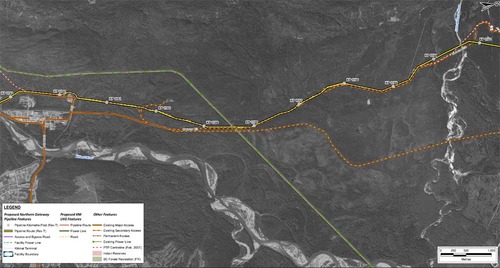Energy Links
According to media reports, Prime Minister Stephen Harper has killed support for the Pacific North Coast Integrated Area Management Initiative (PNCIMA) set up to monitor the ocean on the northern BC coast, while at the same time killing a plan to ban export of bitumen to countries with poor environmental records.
The Calgary Herald, in Harper backs off from initiative that threatens opposition to Northern Gateway pipeline
Prime Minister Stephen Harper’s government has withdrawn support from a deal with the B.C. government and First Nations due to concerns about excessive influence by U.S.-funded environmental groups in the development of an oceans management plan for the B.C. north coast….
There were specific concerns that a new plan being developed under the Pacific North Coast Integrated Area Management Initiative (PNCIMA) could be used to rally opposition to Calgary-based Enbridge Inc.’s proposed $5.5-billion Northern Gateway pipeline that would funnel diluted bitumen crude from Alberta’s oilsands sector to Asian markets docking at Kitimat, B.C.
A letter dated Sept. 1, and sent to the B.C. government, three First Nations groups and the environmental organization Tides Canada, said Ottawa is withdrawing support for a proposed agreement that would have resulted in $8.3 million, from the Gordon and Betty Moore Foundation of Palo Alto, California, to fund the PNCIMA process.
The letter, from Fisheries and Oceans Canada regional director general Susan Farlinger, said the government still intends to come up with an oceans management plan by 2012 in co-operation with B.C. and First Nations.
The Vancouver Sun reports Conservatives’ promise to restrict bitumen exports falls by wayside
The Harper government has quietly buried a controversial promise to ban bitumen exports to countries that are environmental laggards…
One person familiar with Prime Minister Stephen Harper’s surprise announcement during the 2008 federal election campaign said the pledge was simply electioneering at the time and was to be “buried and never seen again.”
Alberta’s energy minister also wonders whether the campaign promise is even a government policy any longer, noting the issue has never been discussed with him during his two years in the portfolio.
However, a spokeswoman for federal Natural Resources Minister Joe Oliver said Wednesday the government policy — designed to halt the flow of raw bitumen and jobs overseas — remains in place but is being regularly examined.
Link Pacific North Coast Integrated Area Management Initiative
Editor’s note:A double standard?
On the issue of the PNCIMA, the controversy is over money for the organization from the foundation set up by the founder of Intel, Gordon Moore.
Moore is famous not only for starting the successful chip company but for Moore’s Law, which has governed the accelerating pace of technological change in the past decades and is described by Wikipedia in Moore’s original formulation: “The number of transistors that can be placed inexpensively on an integrated circuit doubles approximately every two years. This trend has continued for more than half a century…” That simply means that computer processing power can be expected to double every two years.
The Gordon and Betty Moore Foundation, according to the Herald, called for the money to be channeled through a group called Tides Canada.
Support for Canadian environmental efforts by American foundations has long been the subject of a heated campaign by blogger Vivian Krause who told the Herald, “I’m pleased that taxpayers’ money will no longer further a foreign-funded campaign that is against Canadian interests,” Krause said, adding that foundation money should go to the developing world.
Krause says she is an independent commentator. She once worked as Corporate Development Manager for North America for NUTRECO, one of the world’s largest producers of farmed salmon and fish feed but disassociates herself from current public relations campaigns by the fish farming industry. Her online biography says she spent some part of her childhood in Kitimat.
Krause is a favourite of many of the right wing columnists across the PostMedia newspaper chain.
While Krause may have some valid points, one wonders why for Krause and her supporters on the business pages across Canada, that it is perfectly acceptable for the billionaires in the transnational energy industry, many of them American, (as well as the state owned Chinese energy companies) to spend corporate millions supporting the oil sands and the pipelines, while is not acceptable for another American capitalist billionaire to spend his money earned in the free market to support his views on the preservation of the environment.

 In this map, the Enbridge pipeline is yellow with a black outline, the LNG pipeline is red. Where there are yellow and red alternating squares, that means the two pipelines will follow the same route. Solid orange lines are paved roads,broken orange lines are unpaved roads and the green lines are power lines.
In this map, the Enbridge pipeline is yellow with a black outline, the LNG pipeline is red. Where there are yellow and red alternating squares, that means the two pipelines will follow the same route. Solid orange lines are paved roads,broken orange lines are unpaved roads and the green lines are power lines. Just before the pipelines reach the service centre, they diverge, the yellow Enbridge pipeline following the road route around the periphery of the service centre, while the gas pipeline at first follows the route of the Pacific Trails Pipeline and then snakes off at the hydro substation. The two pipelines then run parallel just off Haisla Boulevard across from the Rio Tinto Alcan plant. The green line beside the two pipelines marks a hydro line that would be build to power the facilities.
Just before the pipelines reach the service centre, they diverge, the yellow Enbridge pipeline following the road route around the periphery of the service centre, while the gas pipeline at first follows the route of the Pacific Trails Pipeline and then snakes off at the hydro substation. The two pipelines then run parallel just off Haisla Boulevard across from the Rio Tinto Alcan plant. The green line beside the two pipelines marks a hydro line that would be build to power the facilities. The final map shows the Enbridge pipeline coming into the bitumen/condensate terminal with its large footprint, while the natural gas pipeline continues, crosses Bish Creek and then enters the Bish Cove KM LNG terminal. If the BC LNG terminal is built at North Cove, just west of the proposed Enbridge Northern Gateway facility, a branch pipeline would go from the main gas pipeline down to that facility. (There were indications at the June NEB hearings that negotiations were under way on “sharing” gas “molecules” between the two groups).
The final map shows the Enbridge pipeline coming into the bitumen/condensate terminal with its large footprint, while the natural gas pipeline continues, crosses Bish Creek and then enters the Bish Cove KM LNG terminal. If the BC LNG terminal is built at North Cove, just west of the proposed Enbridge Northern Gateway facility, a branch pipeline would go from the main gas pipeline down to that facility. (There were indications at the June NEB hearings that negotiations were under way on “sharing” gas “molecules” between the two groups). Footprint of the Enbridge Northern Gateway plant.
Footprint of the Enbridge Northern Gateway plant.